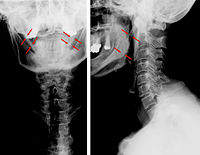
Photo from wikipedia
Background/purpose Review of literature, evaluation of the styloid process (SP) using cone beam computed tomography (CBCT) has not been performed in a Taiwanese population. Our study aimed to evaluate the… Click to show full abstract
Background/purpose Review of literature, evaluation of the styloid process (SP) using cone beam computed tomography (CBCT) has not been performed in a Taiwanese population. Our study aimed to evaluate the different characteristics of SP using CBCT in a Taiwanese population. Materials and methods CBCT scans of 121 patients (55 males, 66 females; mean age, 27 ± 9.09 years) were evaluated to assess the length, morphological type, calcification pattern, and angulation of the SP. A SP length greater than or equal to 30.00 mm is considered to indicate an elongated SP (ESP). ESP was classified in terms of morphology as Type I: uninterrupted; Type II: pseudo-articulated; or Type III: segmented. The calcification pattern of SP was categorized as Type A: calcified outline; Type B: partially calcified; Type C: nodular; or Type D: completely calcified. The transverse and sagittal angles between the bilateral SP were also measured. Results One-hundred and nine patients had a bilateral SP and 12 patients had a unilateral SP. The mean SP length was 26.34 ± 7.44 mm. Forty-two (34.71%) patients had an ESP. The most common ESP morphology was Type 1, followed by Type II, then Type III, while the calcification pattern prevalence was of the descending order Type B, Type A, Type C, and Type D. The mean transverse and sagittal angles were 66.90 ± 5.41° and 26.67° ± 6.50°, respectively. Conclusion The present study was the first to evaluate the characteristics of SP in a Taiwanese population using CBCT. The data contribute a useful basis for clinical investigation of the SP in future.
Journal Title: Journal of Dental Sciences
Year Published: 2022
Link to full text (if available)
Share on Social Media: Sign Up to like & get
recommendations!